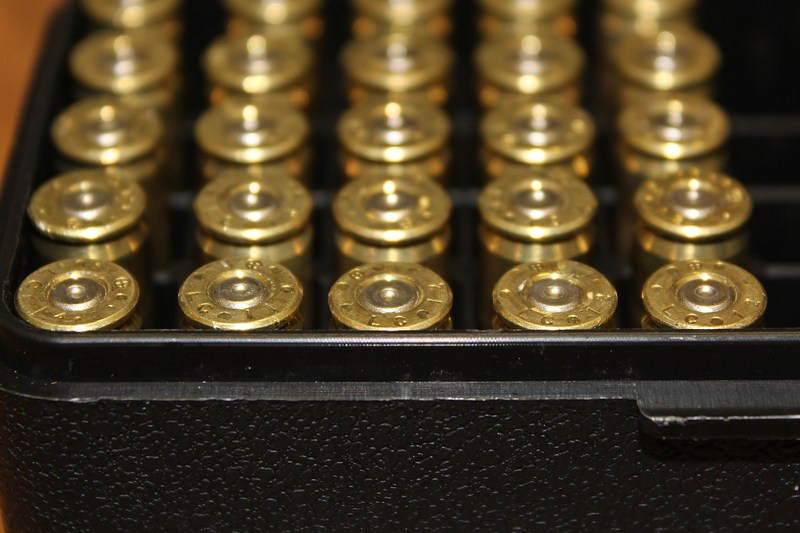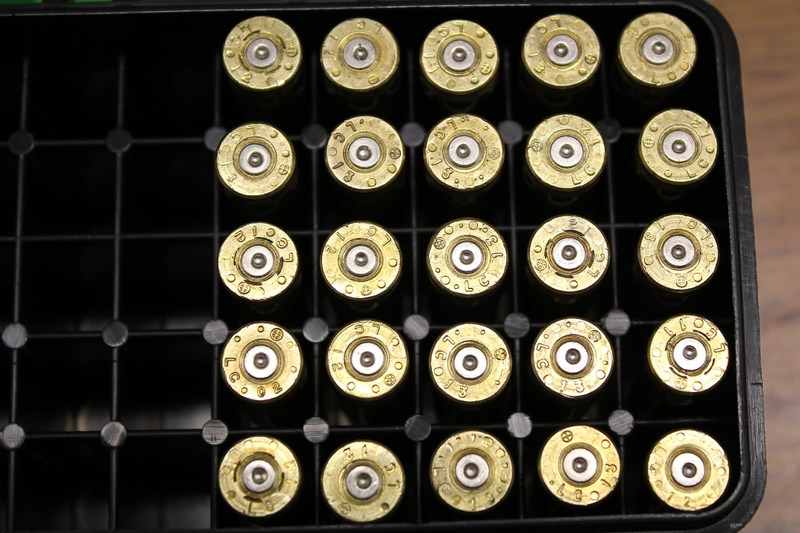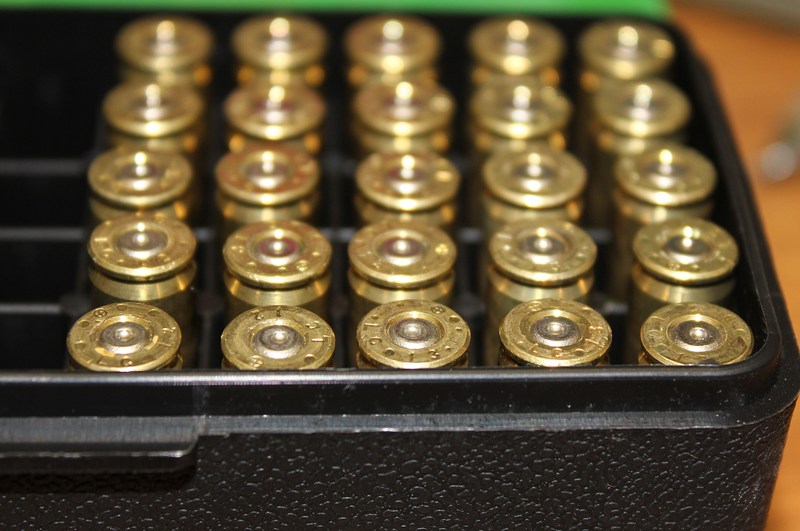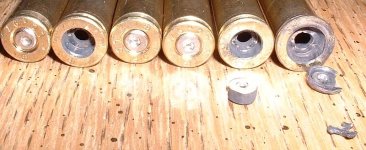You are using an out of date browser. It may not display this or other websites correctly.
You should upgrade or use an alternative browser.
You should upgrade or use an alternative browser.
flattened primers in 223 remington ?
- Thread starter rebs
- Start date
Generally yes, there are other factors that the more technical folks can speak to but flattened primers is certainly a warning sign of possible over pressure.
I will admit to having a load that produces some flattening of primers, not severe though. Came from using an established load without test firing it first in my R-15. First one I fired I noticed were louder and had more OOMPH in the cycling. I try to only fire a few at a time and may try to use them up in my NEF Single shot. .5 grains less is wonderful, but that lil extra of H335 from 24.5 to 25.0, just a little hot for me.
I will admit to having a load that produces some flattening of primers, not severe though. Came from using an established load without test firing it first in my R-15. First one I fired I noticed were louder and had more OOMPH in the cycling. I try to only fire a few at a time and may try to use them up in my NEF Single shot. .5 grains less is wonderful, but that lil extra of H335 from 24.5 to 25.0, just a little hot for me.
Last edited:
Might be, might not. Some primers are just softer. Using primers as an indicator is probably the least accurate way to determine over pressure loads. And all of the conventional methods don't show up until you are well over the limit.
While not 100% reliable a chronograph is the best indicator for the average shooter. If your manual says 25 gr of powder is supposed to yield 3000 fps, then 3000 fps is a max load in your rifle. You may reach 3000 fps at 23 gr of powder or 26 gr of powder depending on the individual rifle and the brass you are using.
When working up loads shoot each over a chronograph and stop before you reach the fastest expected speeds. Don't worry so much how much the powder charge is. Watch the speed. Some rifles and some brass will yield very different speeds with the same powder charge. I wouldn't recommend ever going over the max listed powder charge though. Doing so might be perfectly safe in YOUR rifle, but could be over pressure if that cartridge ever ended up in another gun.
Buying a chronograph is an eye opener. Lots of folks are shooting loads way slower than they need to and many others playing with fire and neither group has a clue.
While not 100% reliable a chronograph is the best indicator for the average shooter. If your manual says 25 gr of powder is supposed to yield 3000 fps, then 3000 fps is a max load in your rifle. You may reach 3000 fps at 23 gr of powder or 26 gr of powder depending on the individual rifle and the brass you are using.
When working up loads shoot each over a chronograph and stop before you reach the fastest expected speeds. Don't worry so much how much the powder charge is. Watch the speed. Some rifles and some brass will yield very different speeds with the same powder charge. I wouldn't recommend ever going over the max listed powder charge though. Doing so might be perfectly safe in YOUR rifle, but could be over pressure if that cartridge ever ended up in another gun.
Buying a chronograph is an eye opener. Lots of folks are shooting loads way slower than they need to and many others playing with fire and neither group has a clue.
condor bravo
New member
Different primers can give different indications of course and typically the CCI 41 small rifle primer is recommended for the AR type rifles. This is a hard primer and would probably show less flattening than others and could be a better high pressure indicator if flattening of that primer does occur. At the other extreme, Federal primers are generally considered to be the softest so flattening with those might not be as good of a pressure indicator as other primers. I would recommend getting the CCI 41s if they are available. The harder 41s are also recommended for preventing something called "slam fires" in rifles with floating firing pins (which I guess includes most AR types as reported in previous threads on the subject--I do not have an AR but the same thing applies to the M-1 Garand that I do use).
condor bravo
New member
Probably then, with the 41s showing flattening, pressures are a bit high at that point in the powder charge. Didn't take much of a charge variation to boost the apparent high pressure.
" I try to only fire a few at a time"
Doesn't make any diff if you fire 1 or 10--it's the one that pops a primer or locks up the action that causes the problems.
"may try to use them up in my NEF Single shot."
I'm not sure that's a good option, either. I'd consider the H&R a weaker action than the AR.
Did you adjust the loads down for use in military cases?
Doesn't make any diff if you fire 1 or 10--it's the one that pops a primer or locks up the action that causes the problems.
"may try to use them up in my NEF Single shot."
I'm not sure that's a good option, either. I'd consider the H&R a weaker action than the AR.
Did you adjust the loads down for use in military cases?
223/5.56 is one of those instances where commercial vs military case capacity is relatively a non-issue.
https://www.northwestfirearms.com/attachments/casecapacities-jpg.122607/
That said, if it went from normal to flat -- especially w/ a CCI-41 -- you are overpressure.
Any burnish/bright marks on the base of the case around the primer pocket?
https://www.northwestfirearms.com/attachments/casecapacities-jpg.122607/
That said, if it went from normal to flat -- especially w/ a CCI-41 -- you are overpressure.
Any burnish/bright marks on the base of the case around the primer pocket?
Flattened primers are often times cause by bumping the shoulder back to far and causing what some call excessive headspace.
When the round is fired, the primer backs out of the pocket. As the case expands, the backed out primer is slammed into the bolt face causing it to flatten giving one the "false" indication of excess pressure.
The same thing can happen with a low pressure load in an oversized case. When the round is fired, the primer backs out of the pocket, but the low/under charge of powder isn't sufficient to expand the case enough to force the primer/head back into the bolt face. In this case the primer will remain backed out of the case.
Scroll down to page three (3).
http://www.loaddata.com/articles/PDF/Load Development May 11.pdf
When the round is fired, the primer backs out of the pocket. As the case expands, the backed out primer is slammed into the bolt face causing it to flatten giving one the "false" indication of excess pressure.
The same thing can happen with a low pressure load in an oversized case. When the round is fired, the primer backs out of the pocket, but the low/under charge of powder isn't sufficient to expand the case enough to force the primer/head back into the bolt face. In this case the primer will remain backed out of the case.
Scroll down to page three (3).
http://www.loaddata.com/articles/PDF/Load Development May 11.pdf
Last edited:
First: I follow manual recommendations and most recommend cutting powder back for military cases. I consider anything with a crimped primer as military until proven otherwise-this includes nearly all FC stamped brass and ALL LC/WCC/foreign stamped brass.
Second: CCI #41 is a "magnum" primer and I've found the need to cut loads at least 1 grain when switching from CCI 400 to CCI 41.
I use a chronograph in addition to other pressure indicators in my load workup and stop when I reach a specific velocity goal regardless of powder charge.
Second: CCI #41 is a "magnum" primer and I've found the need to cut loads at least 1 grain when switching from CCI 400 to CCI 41.
I use a chronograph in addition to other pressure indicators in my load workup and stop when I reach a specific velocity goal regardless of powder charge.
"I have not read or heard about adjusting load down for military brass. Can you give more information on that ?"
The first manual I opened to check says (quote) "Military brass has less case capacity because of it's heavier construction, and often yields higher pressures. We recommend caution when using military brass and suggest starting at or below the minimum loads listed."
I have seen this difference based on loading density(powder level in case) and velocity vs commercial cases so believe it is a viable concern.
The first manual I opened to check says (quote) "Military brass has less case capacity because of it's heavier construction, and often yields higher pressures. We recommend caution when using military brass and suggest starting at or below the minimum loads listed."
I have seen this difference based on loading density(powder level in case) and velocity vs commercial cases so believe it is a viable concern.
I see more than one pressure sign from my AR15:
1) case stretches in front of the web.
2) breech face extractor cut mark on case head.
3) breech face ejector cut mark on case head
4) primer crater up into firing pin hole around firing pin hemisphere
But it does not look flattened.
Holy cow Clark , Now that's some pressure signs  . Do you have any specs on what caused that ? Powder charge , Bullet , Twist , velocity ? I have some numbers and pictures that are retentive this thread using the same components . I'm leaving for work now but will post when I get home
. Do you have any specs on what caused that ? Powder charge , Bullet , Twist , velocity ? I have some numbers and pictures that are retentive this thread using the same components . I'm leaving for work now but will post when I get home
OK I'm back
55gr Winchester / H-335 / CCI #400 primers / 16" barrel 1-7 twist / 5 shot groups @ 100yds
24gr = avg 2803fps - 2814-2768-2807-2828-2798
24.5gr = avg 2872fps -2854-2860-2879-2864-2892
25gr = avg 2927fps - 2911-2924-2914-2900-2967
25.5gr = avg 3006fps - 3060-2991-3007-2988-2985
26gr = avg 3130fps - 3135-3127-3121-3133-3138
These are the cases fired and are in order left to right / low to high charge


there always seemed to be one round that was way off from the others throwing my ES & SD all out of wak . I'm thinking It could have been the way I was holding the rifle .
_____________________________________________________________________
55gr Winchester / H335 / CCI #450 Magnum primers / 16" barrel 1-7 twist same rifle as above . I was having problems with the chrono so I don't have as complete info as above .
24gr = avg 2781fps , ES 69 / SD 29
24.5gr = avg 2875fps , ES 50 / SD 18
25gr = avg 2891fps - 2831-2880-2931-2884-2930 , ES 100 / SD 41
25.5gr = avg 2988fps , ES 68 / SD 28
26gr =avg 3036fps - 3044-3008-3037-3052-3041 , ES 43 / SD 16
Pic of cases , left to right / low to high charge


Everything was the same except the primers . I've been told that when using ball powder like H-335 you should use Mag primers . This appears to show that is really not needed or at least for my set up the #400 are just fine . When using the Mag primers I did not shoot one group under 1.75 moa . How ever using the standard primers I had two good loads . 25gr gave me 1.1 moa and 25.5 gave me a .9 moa .
__________________________________________________________________
Here are some Fed AE 5.56 cases shot on the same day


55gr Winchester / H-335 / CCI #400 primers / 16" barrel 1-7 twist / 5 shot groups @ 100yds
24gr = avg 2803fps - 2814-2768-2807-2828-2798
24.5gr = avg 2872fps -2854-2860-2879-2864-2892
25gr = avg 2927fps - 2911-2924-2914-2900-2967
25.5gr = avg 3006fps - 3060-2991-3007-2988-2985
26gr = avg 3130fps - 3135-3127-3121-3133-3138
These are the cases fired and are in order left to right / low to high charge


there always seemed to be one round that was way off from the others throwing my ES & SD all out of wak . I'm thinking It could have been the way I was holding the rifle .
_____________________________________________________________________
55gr Winchester / H335 / CCI #450 Magnum primers / 16" barrel 1-7 twist same rifle as above . I was having problems with the chrono so I don't have as complete info as above .
24gr = avg 2781fps , ES 69 / SD 29
24.5gr = avg 2875fps , ES 50 / SD 18
25gr = avg 2891fps - 2831-2880-2931-2884-2930 , ES 100 / SD 41
25.5gr = avg 2988fps , ES 68 / SD 28
26gr =avg 3036fps - 3044-3008-3037-3052-3041 , ES 43 / SD 16
Pic of cases , left to right / low to high charge


Everything was the same except the primers . I've been told that when using ball powder like H-335 you should use Mag primers . This appears to show that is really not needed or at least for my set up the #400 are just fine . When using the Mag primers I did not shoot one group under 1.75 moa . How ever using the standard primers I had two good loads . 25gr gave me 1.1 moa and 25.5 gave me a .9 moa .
__________________________________________________________________
Here are some Fed AE 5.56 cases shot on the same day


CAUTION: The following post includes loading data beyond or not covered by currently published maximums for this cartridge. USE AT YOUR OWN RISK. Neither the writer, The Firing Line, nor the staff of TFL assume any liability for any damage or injury resulting from use of this information.
I have shot thousand of rounds of 223 35 gr Vmax 15 gr Blue Dot ~ 3400 fps 35k psi.
The above shot was in a AR15 with 18 gr. At 18 gr some shots have no pressure sign at 4107 ~ 40977 fps, and some destroy the brass with 4127 fps.
Blue Dot is peaky.
When I shoot 20 gr in a Ruger #1, the primer pocket gets twice as big.
While H335 55 gr makes a more orderly work up with flattened primers.
I have shot thousand of rounds of 223 35 gr Vmax 15 gr Blue Dot ~ 3400 fps 35k psi.
The above shot was in a AR15 with 18 gr. At 18 gr some shots have no pressure sign at 4107 ~ 40977 fps, and some destroy the brass with 4127 fps.
Blue Dot is peaky.
When I shoot 20 gr in a Ruger #1, the primer pocket gets twice as big.
While H335 55 gr makes a more orderly work up with flattened primers.
Attachments
Everytime I use factory 62gr mil-spec rounds, I get flattened primers, but not craters. I assume maybe something to do with the mil crimp maybe. I use tula kv-223 in my hot .223 handloads, never notice flattening or cratering. I get extractor marks and obviously noticeable increase in recoil when I get too hot. I use only heavy bullets in my ar with 4064, and I honestly don't think I can compress enough powder in my handloads to injure my rifle
Years ago I ran experiments with surplus LC NM '64. The charge of IMR4895 had only filled the cases about 82% that year. If I got the powder forward in the case, the primer was nicely rounded. If I got the powder over the flash hole by tipping the muzzle up and then level to fire, the primer flattened and velocity increased about 80 fps.
By itself a flat primer only tells you for sure that you are approaching the pressure limits of the primer itself. Some have thinner or softer cups than others, so they aren't anything even approaching being a calibrated pressure gauge. They can only tell you what they, themselves, can or cannot stand by way of pressure. That's important, though, because it predicts piercing is not far behind, along with gas cutting pits into your bolt face.
Regarding Rebs load, it is about 0.2 grains over Hodgdon's maximum of 25.3 grains of H335 for a 55 grain soft point. Plus, Hodgdon used the WSR primer and Rebs ran a #41. I've not run those two primers side-by-side, but whenever you change primers pressure can change, too, so this difference is an additional possible source of extra pressure. My approach would be to back the load down to 25 grains and call that maximum in this gun using this primer and powder and case combination until I could prove otherwise or if the accuracy was better at the hotter load. Some flattening is acceptable. Cratering and the edges of the flat spreading out to remove the rounded edge of the primer cup and starting to fill the chamfer beyond it (mushrooming) are not.
By itself a flat primer only tells you for sure that you are approaching the pressure limits of the primer itself. Some have thinner or softer cups than others, so they aren't anything even approaching being a calibrated pressure gauge. They can only tell you what they, themselves, can or cannot stand by way of pressure. That's important, though, because it predicts piercing is not far behind, along with gas cutting pits into your bolt face.
Regarding Rebs load, it is about 0.2 grains over Hodgdon's maximum of 25.3 grains of H335 for a 55 grain soft point. Plus, Hodgdon used the WSR primer and Rebs ran a #41. I've not run those two primers side-by-side, but whenever you change primers pressure can change, too, so this difference is an additional possible source of extra pressure. My approach would be to back the load down to 25 grains and call that maximum in this gun using this primer and powder and case combination until I could prove otherwise or if the accuracy was better at the hotter load. Some flattening is acceptable. Cratering and the edges of the flat spreading out to remove the rounded edge of the primer cup and starting to fill the chamfer beyond it (mushrooming) are not.


